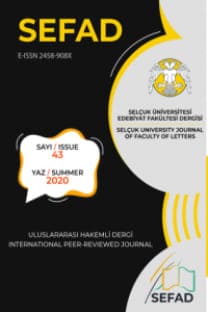HASAN RIZÂYÎ'NİN CÛY-I RAHMET ADLI MANZUM GÜLİSTÂN TERCÜMESİ
Sa dî tarafından XIII. yüzyılda kaleme alınan ve şöhreti İslam coğrafyasını aşarak tüm dünyaya yayılan Gülistân; estetik, pedagojik, İslamî ve insanî pek çok cephesi bulunan bir eserdir. Şark medreselerinde Fars dili ve ahlak eğitimi için bir ders kitabı olarak da kullanılan, bu vesileyle birçok tercüme ve şerhi yapılan Gülistân; hikâyeler arasına serpiştirilen manzum parçaların yanı sıra kendine has dil, üslup ve manzumlarıyla öne çıkmaktadır. Türk edebiyatında Gülistânın bilinen ilk tercümesi XIV. yüzyılda Seyf-i Serâyî tarafından yapılmıştır. Bu özgün eserin XVII. asırdaki tercümelerinden biri de Cûy-ı Rahmet tir. Bu yazıda Hasan Rızâyîye ait olan Cûy-ı Rahmet adlı manzum Gülistân tercümesi tanıtılarak eserin edebiyat tarihimizdeki önemi üzerinde durulacaktır.
HASAN RIZÂYÎ S VERSE TRANSLATION OF GULISTAN NAMED CÛY-I RAHMET
Gulistan, which was written in the 13th century by Sa dî and spread fame throughout the world surpassing the Islamic world, is an aesthetic, educational, Islamic and humanitarian work with many fronts. It was used as a textbook in the orient madrassa for teaching Perssian language and moral education, and therefore many translations and interpretations were made. It is well-known for the poetry pieces interspersed in stories, as well as its unique language, style and expressions. The first known translation of Gulistan in Turkish literature was made by Seyf-i Serâyî in the 14th century. One of the translations of this work in the 17th centuury is Cûy-ı Rahmet . In this study, Hasan Rızâyî s verse translation of Gulistan named Cûy-ı Rahmetwill be introduced and its importance in the history of our literature will be explored.
___
- BAĞDADLI İSMAİL PAŞA (1951). Hediyyetül-Ârifin Esmâ-yı Müellifin ve Âsâr-ı Musannifîn, C.1, İstanbul: Milli Eğitim Basımevi.
- BURSALI MEHMED TAHİR (1971). Osmanlı Müellifleri, C. 1, İstanbul: Matbaa-yı Âmire.
- ÇAĞIRICI, Mustafa (2006). Hasan Rızâyî ve Tezkiretüs-Sâlikîn ile Mahmûdiyye Eserleri Tahkîk ve Değerlendirilmesi, İstanbul (Marmara Ü, Sosyal Bilimler Enstitüsü, Yayımlanmamış yüksek lisans tezi).
- HASAN RIZÂYÎ, Gülistân Şerhi (Cûy-ı Rahmet), Süleymaniye Kütüphânesi Rüstem Paşa Bölümü, No: 869, 416b.
- TURAN, Muhittin (2012, Sonbahar). Hasan Rızâyî ve Kân-ı Maânî İsimli Manzum Sözlüğü, Turkish Studies - International Periodical For The Languages, Literature and History of Turkish or Turkic, Volume 7/4, s. 2939-2992.
- KARTAL, Ahmet (2001, Kış). Sadî Şîrâzînin Gülistân İsimli Eserinin Türkçe Tercümeleri, Bilig-16.
- Yayın Aralığı: Yılda 2 Sayı
- Başlangıç: 1981
- Yayıncı: Selçuk Üniversitesi Edebiyat Fakültesi
Sayıdaki Diğer Makaleler
JUAN GOYTISOLO'NUN KIRK GÜNLÜK SÜRE ADLI ROMANINDA DİNSEL BAĞLAMDA KÜLTÜRLER ARASI DİYALOG
POZİTİVİZM Tarihsel Süreç İçerisindeki Gelişimi ve Sosyolojik Düşünceye Etkileri
RUS DİLİNDEKİ İFADE ZENGİNLİĞİNİN ÇEVİRİ BİLİMİNE VE RUSÇA ÖĞRENİMİNE KATKISI
TÜRKÇE KELİMELERİN EFSANE DÜNYASINDA ANLAMLANDIRILMASI VE ÇÖZÜMLENMESİ
LİVÂYÎ'NİN MANZÛM YASİN TEFSİRİ
MARCUS LICINIUS CRASSUS (M.Ö. 112-53)'UN SURİYE VALİLİĞİ VE BÖLGESEL GÜÇLER
HASAN RIZÂYÎ'NİN CÛY-I RAHMET ADLI MANZUM GÜLİSTÂN TERCÜMESİ
